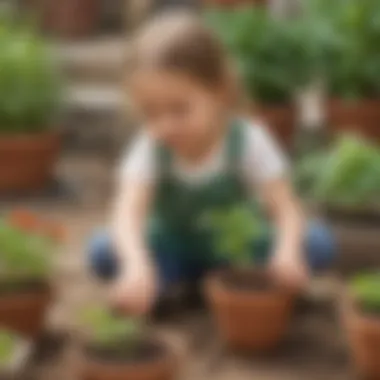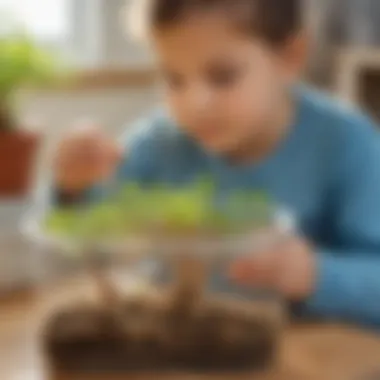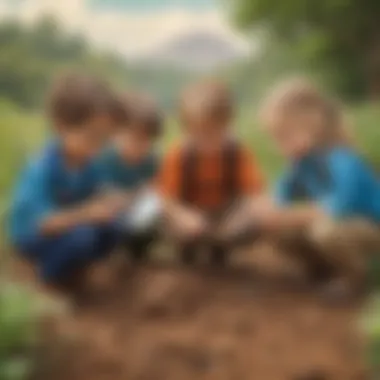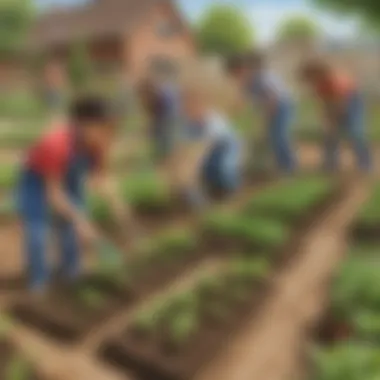Engage Your Little Scientists with Earth Day Planting Activities


Science Fun Facts
Let's kick off our exploration with some fascinating science trivia and quirky stories that will surely captivate the curious minds of our little science buddies. Did you know that the tallest tree ever recorded was a California redwood named 'Hyperion,' towering over 380 feet high? Imagine the excitement of discovering nature's giants in the forests of Earth!
Discover the Wonders of Science
Now, let's dive into the marvels of science by delving into various scientific concepts through engaging activities and educational videos specifically tailored for young scientists aged 6-12. From the intricate world of plant biology to the wonders of photosynthesis, these interactive learning tools will spark a love for nature and scientific exploration.
Science Quiz Time
Are you ready for some brain-teasing scientific challenges? Test your knowledge with interactive quizzes, multiple-choice questions, and intriguing puzzles designed to enhance understanding while having fun. Can you solve the mystery behind the disappearing water trick or decipher the secrets of a seed's growth? Get ready to unravel the wonders of science!
Science Experiment Showcase
Get your lab coats ready as we embark on a journey filled with exciting hands-on experiments! From creating mini ecosystems in jars to exploring the magic of seed germination, these step-by-step instructions will guide our young scientists through safe and engaging activities. Remember to follow the materials list carefully and take necessary safety precautions to ensure a seamless and educational experience.
Educational Value of Planting Activities
Hands-On Learning Experience
Immersing in hands-on planting activities offers children a practical gateway to scientific exploration and ecological understanding. By actively participating in planting herbs, flowers, and vegetables, children engage their senses and scientific acumen, fostering a holistic learning experience. Through tactile interactions with soil, seeds, and plants, young scientists develop a profound appreciation for the intricacies of the natural world. Hands-on learning instills a sense of wonder and discovery, nurturing inquisitive minds and cultivating a lifelong passion for environmental science and sustainability.
Connection to Nature and Science
Planting activities serve as a bridge connecting children to the wonders of nature and the mysteries of science. By delving hands-deep into the earth, young botanists forge a profound bond with the natural world, understanding the symbiotic relationships between plants, animals, and the environment. This intimate connection cultivates empathy, curiosity, and respect for Earth's ecosystems, instilling a conservationist ethos from an early age. Integrating nature and science through planting activities paves the way for a generation of environmentally conscious individuals who appreciate the delicate balance of our planet's ecosystems, equipped to become custodians of the Earth's natural heritage.
Preparation for Planting
In this article, the preparation for planting plays a crucial role in ensuring the success of Earth Day planting activities for young scientists aged 6-12. Selecting the right plant varieties, gathering necessary materials, and understanding the significance of these steps are key components. Adequate preparation sets the foundation for a meaningful and educational planting experience, fostering a deeper connection with nature and science. By focusing on detailed preparation, children can learn the importance of planning and organization in fostering their love for the environment and sustainable practices.


Selecting Plant Varieties
Native vs. Non-Native Plants
When considering plant varieties for Earth Day activities, the choice between native and non-native plants is fundamental. Native plants are indigenous to a particular region and have adapted naturally to the local environment over time. Their presence is crucial in maintaining biodiversity and supporting local ecosystems. On the other hand, non-native plants are introduced from other regions and may not always integrate seamlessly into the existing ecosystem. For this article, native plants are recommended due to their resilience and ability to support local wildlife, making them a beneficial choice for Earth Day planting activities.
Adaptation to Climate
Another essential aspect of selecting plant varieties is their adaptation to the climate of the planting location. Plants that are well-suited to the local climate are more likely to thrive and require less maintenance. Understanding the climate factors such as temperature, rainfall, and soil conditions is vital in choosing plants that can flourish in the designated area. By selecting plant varieties that are adapted to the climate, children can witness the direct impact of environmental factors on plant growth, deepening their understanding of the interplay between nature and science.
Gathering Necessary Materials
Soil
The quality of soil is paramount in ensuring successful plant growth. Soil provides essential nutrients, moisture, and support for plant roots to anchor and spread. The composition of soil, including factors such as texture, drainage, and pH levels, directly influences plant health and growth. By choosing the right soil type based on the selected plant varieties, children can observe the importance of soil quality in fostering healthy plants and sustainable gardening practices.
Seeds or Seedlings
The selection of seeds or seedlings marks the beginning of the planting journey. Seeds offer a hands-on learning experience as children witness the germination process and plant growth from scratch. On the other hand, seedlings provide a head start by skipping the germination phase and allowing children to focus on nurturing and caring for established plants. Both seeds and seedlings have their advantages, offering unique learning opportunities and insights into plant life cycles.
Watering Cans
Watering cans are essential tools for providing plants with the necessary moisture for growth. Understanding the importance of watering plants adequately without over watering is a valuable lesson in plant care. Children can learn about the significance of hydration in plant growth and the role of water in nutrient absorption. By using watering cans responsibly, young scientists can develop crucial skills in plant maintenance and conservation practices.
Fun Planting Activities
In the bustling world of Earth Day planting activities, fun is the key ingredient that keeps the young minds engaged and curious. The notion of fun in planting activities goes beyond just the joy of seeing a seed sprout; it encompasses a holistic experience bridging science, nature, and hands-on learning. Through these engaging activities, children aged 6-12 can delve into the wonders of the environment while fostering a deep-rooted connection with the intricate web of life on our planet. Exploring the realm of fun planting activities opens doors to a world of discovery where children can witness firsthand the magic of growth, the importance of nurturing living beings, and the fascinating interplay between humans and nature.
Planting a Mini Herb Garden
Choosing Herbs to Grow


Embarking upon the journey of selecting herbs to grow presents young botanists with a palette of choices that extend beyond culinary delights. Deciding which herbs to nurture involves considerations of climate suitability, growth patterns, and future utility. Whether opting for robust rosemary or delicate basil, each herb offers a unique gateway to understanding plant diversity and the nuanced requirements of different species. The process of selecting herbs to grow not only instills a sense of responsibility in caring for living organisms but also serves as a gateway to exploring the rich tapestry of herbal lore and its significance in human history.
Planting and Caring for Herbs
Enriching the earth with the roots of herbal wonders, planting and caring for herbs entail a delicate balance of scientific precision and nurturing care. Nestling seeds in soil, ensuring adequate sunlight and water, and observing the gradual growth of these green companions unveil the intricate dance between botany and human attention. Caring for herbs goes beyond the act of watering; it involves a symbiotic relationship between the young gardener and the delicate herbs, fostering patience, diligence, and a keen eye for nurturing new life. Through the process of planting and caring for herbs, children not only cultivate a mini herb garden but also sow the seeds of lifelong appreciation for the marvels of the plant kingdom.
Creating a Floral Paradise
Selecting Colorful Flowers
Setting foot into the realm of creating a floral paradise opens a kaleidoscope of hues and fragrances that delight the senses and nourish the soul. When selecting colorful flowers, young enthusiasts embark on a visual journey where each petal holds the promise of beauty and wonder. The act of choosing colorful flowers transcends mere aesthetics; it delves into the realm of pollination, symbiotic relationships with pollinators, and the role of flowers in sustaining ecosystems. Exploring the world of colorful flowers not only brings joy to young hearts but also nurtures an appreciation for the delicate balance of nature and the interconnectedness of all living organisms.
Arranging the Flower Bed
Weaving together a tapestry of blooms in the sacred space of a flower bed requires careful planning, artistic vision, and a dash of creativity. Arranging the flower bed is akin to painting a living portrait where flowers dance in harmony, colors blend seamlessly, and fragrances waft gently in the air. The art of arranging a flower bed extends beyond visual appeal; it teaches children about spatial distribution, complementary color schemes, and the principles of design in nature. By nurturing the art of arranging a flower bed, young horticulturists not only create visually stunning landscapes but also cultivate an eye for beauty, symmetry, and environmental aesthetics.
Building a Vegetable Patch
Picking Vegetables to Plant
Venturing into the realm of building a vegetable patch embodies a journey of sustainability, nutrition, and hands-on agricultural experience. When picking vegetables to plant, children engage in a process of selection that considers not just personal preferences but also local growing conditions, seasonal variations, and nutritional benefits. Each vegetable chosen for planting offers a window into the world of farming, crop rotation, and the significance of growing one's food. The act of picking vegetables to plant ignites a passion for self-sufficiency, healthy eating habits, and a deeper appreciation for the journey food takes from seed to plate.
Maintaining the Vegetable Patch
Sowing the seeds of a vegetable patch is merely the beginning of a lifelong commitment to nurturing sustenance from the earth. Maintaining the vegetable patch entails tasks of weeding, watering, monitoring for pests, and celebrating the bountiful harvests that follow the tender care invested. Tending to the vegetable patch goes beyond agricultural chores; it instills in young minds the values of patience, resilience, and the gratification of enjoying the fruits of one's labor. By mastering the art of maintaining a vegetable patch, children not only cultivate green thumbs but also sow the seeds of environmental stewardship, resourcefulness, and a profound connection to the earth.
Environmental Impact
Benefits of Planting
Oxygen Production


Supporting Wildlife
Examining the role of Supporting Wildlife in planting activities unveils another significant benefit. Planting provides habitats and food sources for various creatures, fostering biodiversity and ecological balance. Supporting Wildlife through planting initiatives encourages children to appreciate the interconnectedness of different species and ecosystems. This section highlights how planting activities can positively impact local fauna and flora, instilling a sense of respect for all forms of life. By supporting wildlife through planting, children contribute to the preservation of natural habitats and the well-being of diverse animal species.
Promoting Sustainability
Reducing Carbon Footprint
Delving into Reducing Carbon Footprint elucidates a critical aspect of sustainability in Earth Day planting activities. Carbon footprint reduction involves minimizing the emission of greenhouse gases, ultimately mitigating climate change. By engaging in planting activities that absorb carbon dioxide, children actively participate in reducing their environmental impact. This section emphasizes the tangible effects planting has on carbon sequestration, highlighting the role of vegetation in combatting climate change. Through understanding and promoting Reducing Carbon Footprint, children cultivate a sense of environmental responsibility and stewardship.
Conserving Biodiversity
Exploring the significance of Conserving Biodiversity in planting activities unveils the crucial role of preserving the variety of life on Earth. Biodiversity conservation aims to protect and maintain the richness of species within ecosystems, promoting resilience and sustainability. Conserving Biodiversity through planting activities showcases the interconnectedness of different species and habitats, affirming the value of each living organism. This section emphasizes the importance of biodiversity in ensuring ecosystem stability and resilience to environmental changes. By participating in activities that conserve biodiversity, children learn the significance of protecting all life forms and fostering a harmonious coexistence with nature.
Conclusion
In wrapping up this insightful guide on Earth Day planting activities for our young science enthusiasts, it is crucial to underscore the significance of connecting children with nature and fostering a sense of environmental responsibility from a young age. By actively engaging in hands-on planting activities, children not only develop a deeper understanding of the natural world but also cultivate a sense of stewardship towards the environment. Beyond the physical act of planting, these activities are vital in instilling values of sustainability, conservation, and empathy towards all living beings.
Reflection on Planting Activities
Lessons Learned
Discussing the "Lessons Learned" segment of our planting activities, it is essential to reflect on the specific insights children gain through these experiences. From nurturing tiny seeds to witnessing the growth of plants, children grasp the concept of life cycles, patience, and the interdependence of living organisms. A key feature of these lessons is the hands-on approach, which allows for tangible learning experiences and fosters a sense of responsibility and care for nature. While challenges may arise, such as time constraints or unexpected setbacks, the resilience and adaptability developed through these lessons are invaluable for young minds navigating the complexities of our world.
Future Environmental Engagement
Moving forward towards discussing "Future Environmental Engagement," it is imperative to emphasize the role that early exposure to nature plays in shaping a child's environmental consciousness. By encouraging curiosity, exploration, and a sense of wonder towards the natural world, we pave the way for future generations of environmentally aware and proactive individuals. The key characteristic of this engagement lies in creating a lifelong bond between children and nature, inspiring them to become advocates for sustainability and ecological preservation. While challenges such as urbanization and technological distractions may pose threats to this engagement, nurturing a love for nature through planting activities is a powerful tool in shaping a greener and more conscientious future.
Encouraging Continuous Learning
Exploring More Science Activities
Delving into the realm of "Exploring More Science Activities," we unveil a world of endless discoveries and opportunities for growth. By engaging children in hands-on experiments, field trips, and scientific investigations, we ignite their curiosity and passion for learning. The key characteristic of these activities is their ability to merge theoretical knowledge with practical application, allowing children to see science come alive before their eyes. Despite potential challenges such as limited resources or time constraints, the intrinsic joy of discovery and the spirit of inquiry cultivated through these activities far outweigh any obstacles.
Sharing Knowledge with Peers
Lastly, focusing on "Sharing Knowledge with Peers," we emphasize the importance of collaboration and communication in the realm of science education. By encouraging children to share their learning experiences, insights, and questions with their peers, we create a vibrant community of young scientists eager to explore the world together. The unique feature of this sharing process is the reciprocal learning that takes place, where each child contributes their unique perspectives and discoveries, enriching the collective understanding of the group. While challenges such as shyness or difficulty in articulating thoughts may arise, the practice of sharing knowledge not only strengthens communication skills but also instills a sense of camaraderie and teamwork among young learners.







